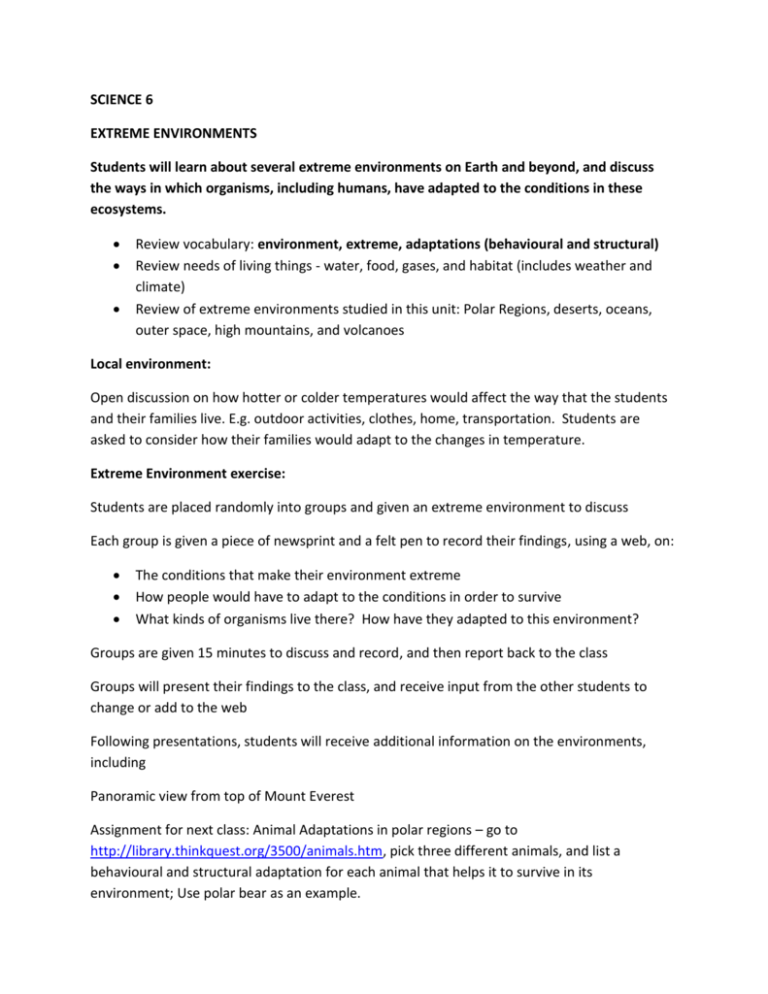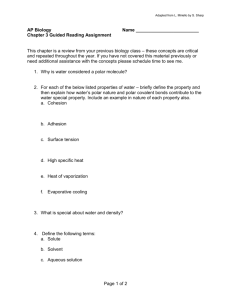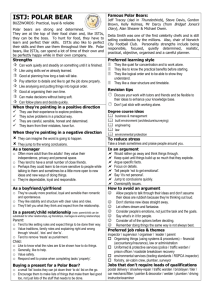Science_Extreme_Environments
advertisement

SCIENCE 6 EXTREME ENVIRONMENTS Students will learn about several extreme environments on Earth and beyond, and discuss the ways in which organisms, including humans, have adapted to the conditions in these ecosystems. Review vocabulary: environment, extreme, adaptations (behavioural and structural) Review needs of living things - water, food, gases, and habitat (includes weather and climate) Review of extreme environments studied in this unit: Polar Regions, deserts, oceans, outer space, high mountains, and volcanoes Local environment: Open discussion on how hotter or colder temperatures would affect the way that the students and their families live. E.g. outdoor activities, clothes, home, transportation. Students are asked to consider how their families would adapt to the changes in temperature. Extreme Environment exercise: Students are placed randomly into groups and given an extreme environment to discuss Each group is given a piece of newsprint and a felt pen to record their findings, using a web, on: The conditions that make their environment extreme How people would have to adapt to the conditions in order to survive What kinds of organisms live there? How have they adapted to this environment? Groups are given 15 minutes to discuss and record, and then report back to the class Groups will present their findings to the class, and receive input from the other students to change or add to the web Following presentations, students will receive additional information on the environments, including Panoramic view from top of Mount Everest Assignment for next class: Animal Adaptations in polar regions – go to http://library.thinkquest.org/3500/animals.htm, pick three different animals, and list a behavioural and structural adaptation for each animal that helps it to survive in its environment; Use polar bear as an example. Desert Animals Go to: http://www.woodlands-junior.kent.sch.uk/Homework/adaptations/desert.htm http://www.desertusa.com/survive.html and pick three different animals, and list a behavioural and structural adaptation for each animal that helps it to survive in its environment; Desert Conditions The two main adaptations that desert animals must make are how to deal with lack of water and how to deal with extremes in temperature. Many desert animals avoid the heat of the desert by simply staying out of it as much as possible. Where do animals in the desert get their water from? Since water is so scarce (less than 25 mm of rain per year), most desert animals get their water from the food they eat: succulent plants, seeds, or the blood and body tissues of their prey. How do desert animals prevent water from leaving their bodies? Desert animals prevent water leaving their bodies in a number of different ways. Some, like kangaroo rats and lizards, live in burrows which do not get too hot or too cold and have more humid (damp) air inside. These animals stay in their burrows during the hot days and emerge at night to feed. Other animals have bodies designed to save water. Scorpions and wolf spiders have a thick outer covering which reduces moisture loss. The kidneys of desert animals concentrate urine, so that they excrete less water. Polar Animals How are animals living in the polar region adapted to the conditions in which they live in? Animals of the Arctic have many adaptations to help them survive in often inhospitable climate. Polar Bears A polar bear lives in the cold, snowy Arctic lands. They are the largest land carnivores. How has a polar bear adapted to its Arctic environment? Why are polar bears white? Their white fur helps them blend in with the snow and ice. How does a polar bear keep warm? A polar bear has a layer of fat under its skin which helps it stay warm. It also has a thick layer of fur. Why does a polar bear have very wide, large paws? The wide, large paws help a polar bear to walk in the snow. Why does a polar bear have nostrils which it can close? When a polar bear swims under water it closes it nostrils so no water can get in. Polar Bears Why will we not find a polar bear living in a desert? Polar bears are adapted to suit a cold environment. If a polar bear was adapted to live in a desert: What colour would the polar bear be so it was camouflage? Would it still have thick fir? What would it eat? Deep Sea Environment http://www.oddee.com/item_79915.aspx pictures and descriptions for class presentation – not for distribution to class http://www.ted.com/talks/david_gallo_shows_underwater_astonish ments.html camouflage and bioluminescence http://english.pravda.ru/photo/album/water_bears-2685/1 / Information and photos of tardigrades






